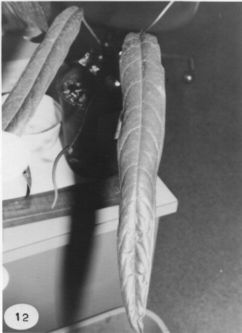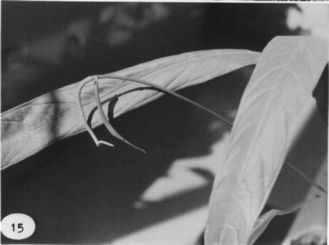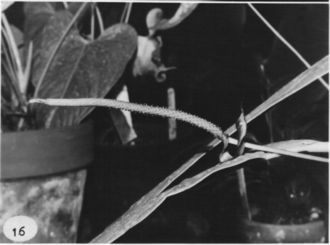



Anthurium cerropirrense Croat, sp. nov.
TYPE: Panama. Darien: Serrania de Pirre, 9-10 km N of Alturas de Nique, lower
montane rain forest (Holdridge Life Zone System), 1,520-1,560 m, Croat
37857 (MO 2416646, holotype; K, PMA, US, isotypes; Live at MO).
Planta epiphytica; caudex usque 20 cm longus; cataphyllum subcoriaceum, deciduum;
petiolus teres, 26-47.5 cm longus; lamina subcoriacea, lanceolata ad anguste
elliptica, basi acuta ad late rotundata, 23-48 cm longa, 5.5-13 cm lata; inflorescentia
effusa; pedunculus teres, 28-60 cm longus; spatha modice membranacea, viridis,
linearis-lanceolata, 5.5-10 cm longa; spadix olivaceus pallidus, 11-12 cm longus;
pistillum purpureum; baccae purpurascentes, 8 mm longae.
Epiphyte; stems elongate 20 cm or more long; internodes 0.8-1 cm long; roots
few, thick, green; leaf scars 1.5-2 cm wide; cataphylls subcoriaceous, 15-17
cm long, acute at apex, drying brown, persisting briefly intact, soon deciduous.
LEAVES spreading; petioles 26-47.5 cm long, terete; geniculum
1.5-2.5 cm long; blades sub-
coriaceous, lanceolate to narrowly elliptic, long acuminate at apex,
acute to broadly rounded at base, 23÷48 cm long, 5.5-13 cm wide, broadest
at the middle or just below; both surfaces matte to semiglossy with numerous,
minute raphide cells; midrib scarcely raised, convex at base, more acute
at middle, sunken at apex above, prominently and convexly raised below;
primary lateral veins 12-14 per side, departing the midrib at 35-45°
angle, arcuate to collective vein, sunken above, raised below; interprimary
veins flat above, prominulous below; collective vein arising from one primary
lateral vein usually in the lower one-third of the blade, sunken above,
raised below, 4-7 mm from the margin.
INFLORESCENCE spreading, shorter than leaves; peduncle 28-60
cm long, 2.5-3 mm diam., terete, ca. 2 times longer than petioles; spathe
moderately thin, green (B & K Yellow-green 6/7.5), linear-lanceolate,
5.5-10 cm long, acuminate at apex. obtuse to acute at base, inserted at
65-70° angle:
stipe 3-7 mm long; spadix pale olive green, 11-12 cm long, 5-6 mm diam.
near base, narrowly tapered at apex; flowers rhombic to 4-lobed, 2-2.6
mm long, 2-2.4 mm wide, the sides straight to weakly sigmoid, 4-7 flowers
visible in the principal spiral, 7-10 flowers visible in the alternate
spiral; tepals matte to semiglossy, minutely papillate, lateral tepals
1-1.8 mm wide. the inner margin straight to weakly concave; pistils emergent,
tinged violet purple; stigmas green. oblong-elliptic, 0.5 mm long; stamens
emerging in a scattered manner beginning at base, laterals emerging one
at a time, the third and fourth stamens emerging several days after laterals,
exsen-ed on translucent filaments ca. 3 mm long- retracting to hold anthers
at level of tepals; anthers pale yellow-orange, 0.3-0.5 mm long, 0.5-0.7
mm wide; thecae ovate-elliptic, weakly divaricate; pollen yellow-orange,
fading to white.
INFRUCTESCENCE probably with purple berries. acute at apex, ca.
8 mm long, ca. 3 mm wide (dry). Figs. 12, 15,
and 16.
Anthurium cerropirrense is known only from Cerro Pirre in Darien
Province in Panama at 800 to 1,560 m in lower montane rain forest.
The species, tentatively placed in section Xialophyllium,
is distinguished by its elongated stem with short internodes, its long
cataphylls. and by its narrowly elliptic to lanceolate leaf blades
with the collective vein arising from one of the primary lateral veins
in the lower third of blade. It is also distinguished by its pale olive
green spadix with emergent, purplish pistils and berries.
It is probably most closely related to Anthurium testaceum
from western Panama near Costa Rica, but that species has fewer flowers per
spiral with prominently raised tepals and red berries. In addition A. testaceum
has more elongate internodes (at least in the lower part of the stem). One specimen
(Folsom 4504) of A. cerropirrense has a similar leaf shape to
that of A. testaceum but has the flowers and berries of A. cerropirrense.
In the revision of the Anthurium of Costa Rica (Croat & Baker,
1979), several collections of A cerropirrense were listed in the
exsiccatae of A. testaceum. These are Bristan 619, Duke &
Elias 13822, Duke 6094, and Folsom 4504.
Map of Mesoamerican specimens with coordinates
Panama Darien: 800-1050 m, 7.56N 77.45W, 29 June 1988, Thomas B. Croat
68948 (MO).
Panama Darien: 800-1050 m, 7.56N 77.45W, 29 June 1988, Thomas B. Croat
68949 (MO).
Panama Darien: Cerro Pirre, 1000-1080 m, 8.00N 77.45W, 14 September
1989, G. McPherson 14085 (MO).
Panama Darien: 1520-1560 m,, 27 July 1976, Thomas B. Croat 37857 (MO).






